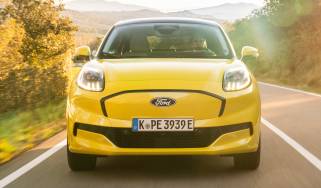Audi Q3 SUV - MPG, running costs & CO2
Fuel economy figures for the Audi Q3 compare well with rivals
To attract buyers away from less expensive models into a premium car like the Audi Q3, affordable running costs are important. On paper, the least powerful versions of the Q3 should appeal to those with a strict motoring budget in mind, but costs increase sharply with more powerful models. The 45 TFSI e plug-in hybrid model boasts the lowest running costs of any model in the Q3 range and gives Audi a rival for the Mercedes GLA 250 e and BMW X1 xDrive25e.
Audi Q3 MPG & CO2
The entry-level 1.5-litre petrol engine, badged 35 TFSI, manages up to 44.8mpg and CO2 emissions of between 143-160g/km of CO2, depending on the exact spec and whether you opt for the manual or S tronic gearbox. Above that is a mid-range 40 TFSI, which returns up to 34.4mpg and from 185g/km. Both the 40 and 45 TFSI models are only available with an automatic gearbox and four-wheel-drive, but the extra power of the range-topper doesn't hurt fuel economy too much. The 45 TFSI, unavailable on Sport trim, offers up to 32.5mpg and from 197g/km of CO2, while both these petrols occupy the top Benefit-in-kind (BiK) bracket, making them a poor choice for company-car drivers.
The sole 2.0-litre diesel engine is available with power outputs of either 148 or 197bhp. The former, badged 35 TDI, is offered with a combination of front wheel drive and the S tronic automatic, and is easily the most economical. Up to 56.5mpg is promised on entry-level cars, while CO2 emissions start from 132g/km. The more powerful 40 TDI returns up to 42.8mpg with CO2 emissions from 172g/km depending on the size of the wheels fitted, and is only available in quattro form.
More reviews
Car trim reviews
In-depth reviews
Road tests
Used car reviews
The plug-in hybrid 45 TFSI e model is the one to go for as a company car, as it sits in a low Benefit-in-Kind tax bracket thanks to emissions of 44g/km. Its fuel economy figure of up to 176.6mpg is really an indication of what’s theoretically possible – it really depends on how often you charge the battery.
VED (tax) is charged at the standard rate for all petrol and diesel models, falling by £10 for the Q3 plug-in hybrid, unless you cross the £40,000 mark (any S Line model above the 40 TDI, and any Black Edition above the 35 TDI), in which case the car is also liable for the 'expensive car surcharge' in the first five renewal years.
Insurance
The least powerful 35 TFSI 1.5-litre petrol model has an insurance group 23E rating, which is not much higher than its predecessor. Choose the 40 TFSI 2.0 petrol and it sits in insurance group 30E, and the most powerful 227bhp 2.0-litre 45 TFSI petrol is insurance group 35E.
The entry-level 148bhp 2.0-litre diesel attracts a rating of group 25E in standard trim with four-wheel drive, rising to group 30E for the 197bhp 40 TDI quattro model in S Line trim.
Servicing
Audi service intervals are based on either a fixed or variable schedule, with the former intended for those who cover fewer than 12,000 miles a year. The latter uses sensors to measure wear-and-tear factors such as oil quality, and the car will notify its driver when it's time for a visit to the workshop. Intervals could potentially be as long as 24 months apart.
Your Audi dealer will be pleased to offer a service package to cover routine maintenance of your Q3, based on your expected annual mileage.
Warranty
Audi offers a three-year/60,000-mile warranty. It can be extended at extra cost, but remains less than generous by comparison to the three-year/unlimited-mileage policies offered by Mercedes and BMW, and even longer warranties offered by non-premium makers such as Kia and Hyundai.
Which Is Best?
Cheapest
- Name35 TFSI Sport 5dr
- Gearbox typeManual
- RRP£35,490
Most Economical
- Name35 TDI Sport 5dr S Tronic
- Gearbox typeSemi-auto
- RRP£38,670
Fastest
- Name45 TFSI 245 Quattro S Line 5dr S Tronic [Leather]
- Gearbox typeSemi-auto
- RRP£46,015












